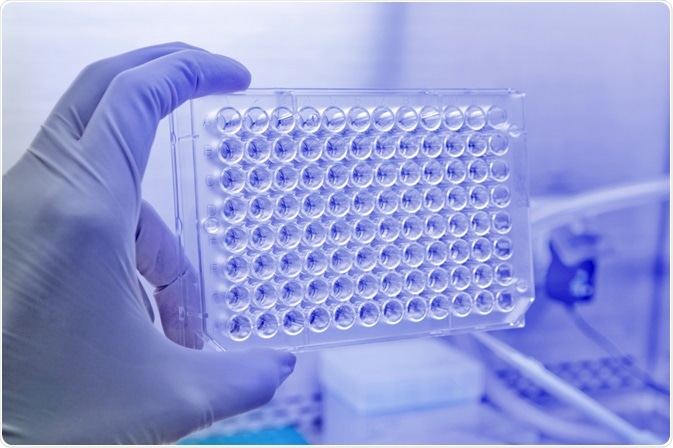Measures of cell viability and cytotoxicity are essential for the development of new drug treatments for cancer. For a number of years, cell-based assays have been used to assess the impact of drugs on cell viability (the number of live cells), and the drug’s cytotoxicity (the toxic quality of the drug on the cells).
 Image Credit: ArtPanupat / Shutterstock.com
Image Credit: ArtPanupat / Shutterstock.com
These measures can analyze the potential effectiveness of a new drug through understanding how successful it is at causing cell death to the targeted cancer cells.
Cell viability
Assessing cell viability is fundamental to the analysis of the efficacy of a new drug or treatment. In general, cell viability is a measure of cell health. Agents acting on cells, such as a potential new drug, impact the cell’s health and metabolism, but to different degrees.
Not all drugs work by the same mechanism or with the same level of effect, so analyzing how they impact cell health can be a key indicator of which drug may work for a given intended outcome.
The measure of cell viability is the quantification of the number of living cells, usually expressed as a percentage of the control. Cell viability assays are often used alongside cytotoxicity tests to help to understand how a drug’s toxicity is impacted by cell health.
Cell viability assays
Numerous methods have been developed to evaluate cell viability. Such methods include optical (IVIS) imaging, confocal imaging, and analyses of perfusate/circulating culture medium, the latter being a technique that can evaluate 3D cultures or tissue surrogates over a length of time. Each of these methods is non-destructive and can be used to study the effectiveness of cancer treatments, due to the fact that they can be carried out in vivo.
These cell viability assays are heavily relied on to test the impact of potential new cancer therapies and are often used alongside tests of cytotoxicity.
Cytotoxicity
Cytotoxicity refers to the toxic quality that a substance presents to the body’s cells. The toxicity of a substance can impact a cell in various ways, leading to numerous cell fates. Most common of these fates are types of cell death, including necrosis: the loss of cell membrane integrity leading to death through cell lysis and apoptosis: genetically programmed cell death.
Assays that measure cytotoxicity will look at the substance’s ability to kill cells. The investigated substance is usually a drug that is being trialed, but it can also be a chemical, the toxicity of which needs to be known to protect the people working with it.
Cytotoxicity assays
The pharmaceutical industry uses a variety of cytotoxicity assays to screen compounds. A library provides the key to the cytotoxicity of compounds that have already been investigated, and this is available to researchers who are developing new therapeutic approaches. The library allows researchers to filter through compounds based on their impact on cells.
Tests of cytotoxicity are seen as being one of the most important indicators of biological activity. Chemicals, drugs, and pesticides all impact human cells in different ways, and these assays can uncover the exact mechanisms of how they work in the human body.
Cytotoxicity assays can uncover processes such as the destruction of cell membranes, irreversible binding to receptors, prevention of protein synthesis, irreversible binding to receptors, and others.
The advent of new and improved cytotoxicity assays that are reliable, robust, and affordable has been fundamental to the advancement of the pharmaceutical development process. With these assays, research has begun to rely less on animal testing, as well as being more cost-effective and less time-consuming.
Cytotoxicity, cell viability, and cancer
Irregular cell growth is the hallmark of cancer. Cells that divide rapidly are the target of chemotherapeutic drugs, which attempt to eliminate cancer by destroying these abnormally growing cells. The basis of how chemotherapeutic drugs work is that they damage cells that are dividing, causing them to die.
The problem here is that normal cells also divide, so they too become damaged, leading to adverse side effects from the therapy. This kind of therapy is able to work because cancer cells are often dividing significantly faster than healthy cells, so they are more susceptible to the impact of chemotherapeutic drugs.
However, research is continually looking at how current methods can be improved in order to increase the cancer cell killing power of therapies and to limit the side effects.
Tests of cytotoxicity and cell viability are key elements to designing new drug treatments that are more effective at killing cells and produce fewer unwanted side effects. This is because their impact on cells can be tested in vivo or in vitro to allow scientists to understand how they will act on different kinds of cancers.
Other applications
Assays of cell viability and cytotoxicity are most often used in the development of new cancer drugs. However, they are not limited to use in this application. These tests are appropriate for any research scenario that needs to investigate the impact of a substance on cell health. Sometimes the toxicity of a substance will need to be tested to measure its potential harm to humans.
Sources
Aslantürk, Ö. (2018). In Vitro Cytotoxicity and Cell Viability Assays: Principles, Advantages, and Disadvantages. Genotoxicity - A Predictable Risk to Our Actual World. www.intechopen.com/.../in-vitro-cytotoxicity-and-cell-viability-assays-principles-advantages-and-disadvantages
Farghadani, R. et al. (2016) “35Year Research History of Cytotoxicity and Cancer: a Quantitative and Qualitative Analysis.” Asian Pacific journal of cancer prevention, pp. 3139-45. https://www.ncbi.nlm.nih.gov/pubmed/27509942
Fang, I. and Trewyn, B. (2012). Application of Mesoporous Silica Nanoparticles in Intracellular Delivery of Molecules and Proteins. Methods in Enzymology, pp.41-59. https://www.sciencedirect.com/science/article/pii/B9780123918604000033
Further Reading